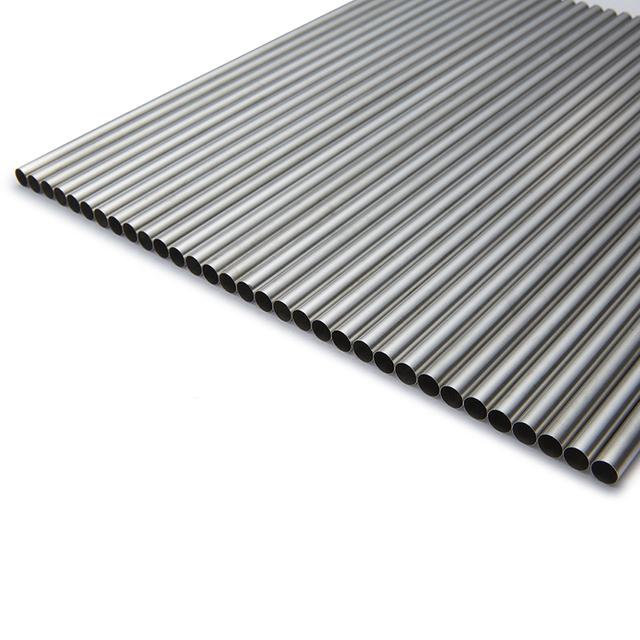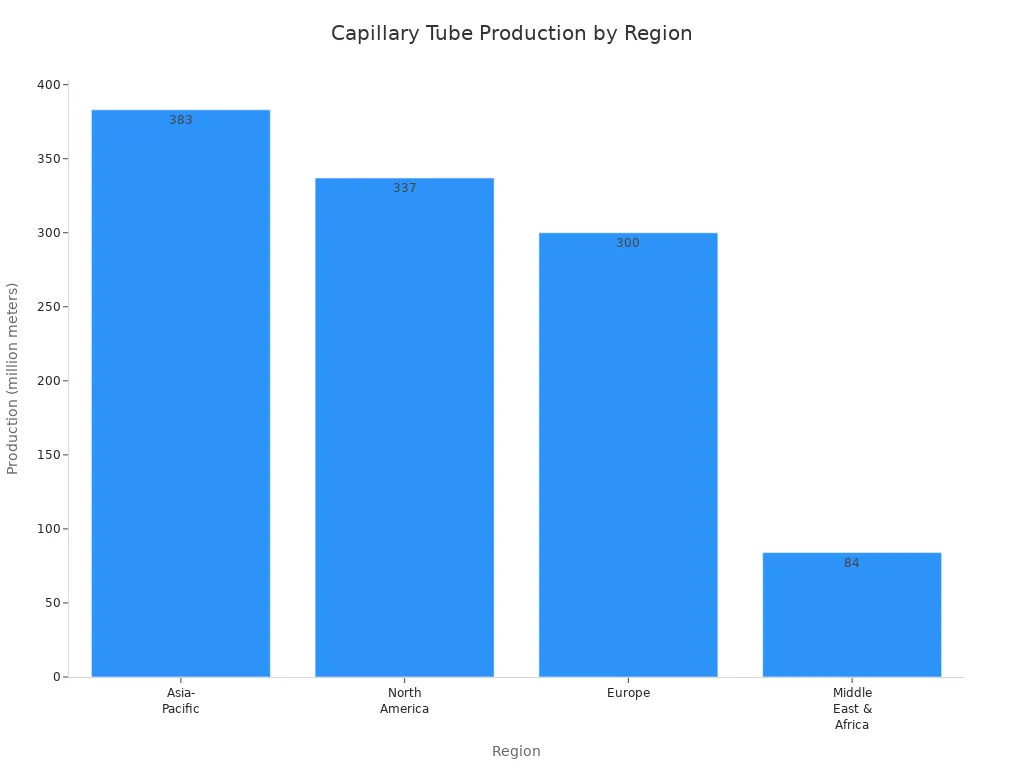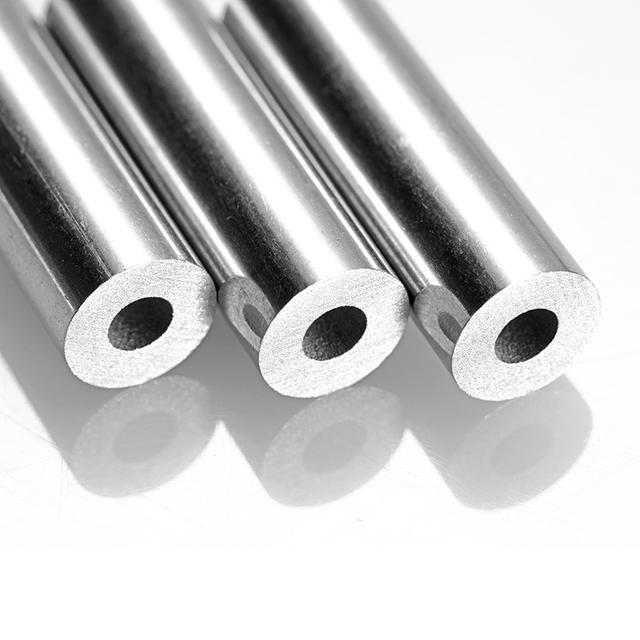Views: 0 Author: Site Editor Publish Time: 2025-09-09 Origin: Site











You will notice new trends in capillary tube uses. These trends will change how industries work in 2025. The newest capillary tube designs are very thin and made with great care. This makes them strong and dependable, even in tough places. Huashang Steel is a leader in this area. They set new rules with their advanced Tube solutions. Many fields, like medical and aerospace, now use capillary tubes for better results.
Segment Type | Insights |
|---|---|
By Type | Deep look at main things that help growth |
By Application | Learn about main industry parts and how fast they grow |
Regional Analysis | Learn about chances in the world, regions, and countries |
You can use these ideas to help your business grow.
Capillary tube uses are growing in healthcare, aerospace, and food. Companies should look at these chances to make their work better.
New materials like stainless steel and advanced polymers help tubes work well. Pick tubes made from these materials for stronger and safer use.
Making things smaller and using cloud solutions are big trends. Buy small, easy-to-carry devices for flexible tests and online data storage.
Keep up with rule changes. Following new standards keeps things safe and good, and helps customers trust you.
Work with top makers like Huashang Steel. Teaming up with experts gives you new products and technology.
The capillary tube market is growing fast. In 2023, plastic capillary blood collection tubes made $600 million. Experts think this number will reach $800 million by 2028. The market grows about 4% each year. Healthcare, environmental testing, and food and beverage industries need these tubes. They use them for medical devices, safe sample checks, and clean fluid movement. Peek capillary tubing is also becoming more popular. This shows how much these industries matter.
Here is a quick look at the top regions for capillary tube making and use:
Region | Production (million meters) | Global Share (%) | Key Contributors |
|---|---|---|---|
Asia-Pacific | 383 | 32 | China, India, Japan |
North America | 337 | 28 | U.S., Canada, Mexico |
Europe | 300 | 25 | Germany, UK, France |
Middle East & Africa | 84 | 7 | UAE, Saudi Arabia |

There are some big trends in the capillary tube market for 2025. Miniaturization and portability are important. Companies want smaller devices that are easy to move. These devices help with testing in many places. Cloud-based data solutions are also growing. These platforms let you check viscosity data from anywhere. You can watch how things work even if you are far away. Customization is another trend. You can pick viscometers that fit your needs. Some have temperature control or automation.
Trend | Description |
|---|---|
Miniaturization and Portability | Smaller, portable viscometers allow flexible testing in many environments. |
Cloud-Based Data Solutions | Cloud platforms help you manage viscosity data and monitor performance remotely. |
Customization Options | Custom viscometers fit specific industrial needs, like temperature control and automation. |
Huashang Steel is a leader in making advanced products. Their capillary tube solutions are very precise and reliable. These trends help companies make better and more flexible products.
New materials are changing the capillary tube market. Makers use new materials to make tubes work better and last longer. Stainless steel, nickel alloys, titanium, and advanced polymers are popular choices. These materials have many good points:
Corrosion resistance keeps tubes strong in tough places.
High strength helps tubes handle lots of pressure.
Versatility means tubes work with many fluids and gases.
Temperature resistance keeps tubes working in hot or cold spots.
Hygienic properties make tubes easy to clean for medical and food uses.
Durability means tubes last longer and need less fixing.
Stainless steel capillary tubes are used in hydraulic systems. They help control fluid flow in high-pressure places and do not rust easily. Nickel alloys work well in very hot conditions. They stay strong even when it is hot. Glass tubes are best for labs. They do not react with chemicals and you can see inside them. Advanced polymers are good for single-use medical jobs. Ceramics and composites are starting to be used in aerospace and defense.
Precision engineering for capillary tubes is getting better. Flow controllers help you control fluids and gases very accurately. Liquid and gas chromatography tubes help you separate and study samples in hard conditions. Cytometry tubes are made to exact sizes for counting cells. Particle sizing tubes give you good measurements for particle spread. Chemistry and materials science use capillary tubes for research. Microelectronics and microfabrication need tubes with tight sizes. Healthcare and life sciences use these tubes for tests and lab work. Pharmaceuticals use them for finding new drugs and checking quality.
New technology in factories, especially in China, has made capillary tubes even better. These changes help tubes meet strict world standards. Bright annealing is a process that helps a lot. It makes tubes smooth and shiny. It also gives them a uniform structure. This process helps tubes resist rust and keeps stainless steel strong. These changes help tubes work well in sensitive industries like medicine and food. Companies like Huashang Steel use these methods to stay ahead and meet high standards.
Tip: When picking capillary tubes, choose ones made with new materials and precise engineering. These features help you get good results in your work.

Capillary tubes are important in medicine. Hospitals use them to collect blood. Blood testing centers and donation places also use them. These tubes help doctors get the right amount of blood. Hospitals use almost half of all these tubes. Blood testing centers use about one-third. Blood donation places use some too. Ambulatory care centers use the rest.
Application | Market Share (%) |
|---|---|
Hospitals | 45 |
Blood Testing Centers | 30 |
Blood Donation Facilities | 15 |
Ambulatory Care Facilities | 10 |

Capillary tubes help get exact blood samples. New tube designs work better and are safer for people. Self-wicking technology helps give the same amount every time. Stainless steel and tantalum tubes are strong and do not rust. This makes them good for medical jobs.
Industries use capillary tubes in many ways. Refrigeration units use them to move refrigerant. Labs use glass tubes for X-ray tests. Huashang Steel makes special tubes for different needs. You can find these tubes in energy, food, and chemical plants. They are also in gas, pharmacy, and other places. Some tubes are used as injection needles. Others guide temperature sensors.
Characteristic/Application | Description |
|---|---|
Precision | Tubes can be very thin and have strong walls. |
Surface Quality | Bright annealing makes tubes smooth and shiny. |
Industrial Applications | Used in many fields like energy, food, and medicine. |
Specific Uses | Used for needles, sensors, and protecting electronics. |
Cars use capillary tubes to move fluids. They help control how cold or hot things get. Copper tubes work well because they handle heat. Titanium tubes protect car sensors from water and dust. This keeps sensors working longer and better.
Capillary tubes help make new electronics and sensors. Freeze protection sensors use these tubes to check temperature. They turn on heat if it gets too cold. Temperature sensors in water heaters use these tubes too. In microelectronics, capillary tubes help put ink in the right spot. Flexible tubes help cool small devices.
Aerospace uses capillary tubes in fuel and air systems. These tubes are light and can handle tough conditions. In energy, they work in power plants and nuclear sites. Superalloy tubes move steam and block radiation. Special materials from Huashang Steel help these tubes last and work well.
New rules are changing how capillary tubes get made and used. In France and the European Union, agencies set stricter standards. These rules focus on making tubes accurate and safe. They also help protect the environment. Makers must improve their tubes to meet these rules. This is very important for pharmaceuticals, chemicals, and food safety. International standards matter too. They tell companies to use recyclable materials and follow safety steps. These rules help people trust capillary tubes. They know the tubes are safe and made with care. Huashang Steel works hard to follow all these rules. This helps the market grow and keeps quality high.
Research and new technology make capillary tubes better. Scientists and engineers find new ways to make tubes safer. They also make tubes work better.
Recent breakthroughs in bioengineering help create human capillary tube networks. These networks have real-life sizes. This helps tissue engineering and medical research.
New micro-collection tubes lower contamination risks. Self-sealing blood collection tubes make transport safer. Investment in technology helps factories make more tubes. It also helps with quality control. Makers use automated machines and laser welding. Startups work on custom designs. This leads to more new ideas. These efforts help the market grow and meet industry needs.
Many industries need more capillary tubes. Several things make this demand strong:
New technology makes tubes work better and last longer.
People want energy-efficient HVAC and refrigeration systems.
The food and beverage industry is growing fast.
Governments support eco-friendly solutions, so demand goes up.
New industries also help the market grow. Medical diagnostics and research need better tubes. Glass capillary tubes are important for lab tests and blood collection. Stainless steel tubes are used in healthcare, cars, and aerospace.
Source | Type of Evidence | Key Points |
|---|---|---|
Capillary Tube Accessories Market | Market Overview | New ideas in medical diagnostics and research help markets grow. |
Global Glass Capillary Tubes Market | Market Research | Glass tubes are needed for blood collection and lab tests. |
Stainless Steel Capillary Tube Market | Market Trends | Healthcare, cars, and aerospace need more stainless steel tubes. |
Tip: You can do well by picking capillary tubes that meet new rules and use the latest technology.
Capillary tube technology changes often. You have to learn about new designs and materials. Many industries want tubes that are very small and exact. This makes making them harder. Factories need special machines and skilled workers. Sometimes, it is hard to find the right materials for some jobs. Not all materials work everywhere. You must pick the right tube for your job. If you choose wrong, your project might fail.
You can have problems with cost and getting supplies when using capillary tubes. Here are some common problems:
Supply chain problems can make it hard to get materials. The COVID-19 pandemic showed these systems can break easily.
If you use suppliers from other countries, you might have shortages or delays.
These problems can hurt healthcare and make customers lose trust.
The market always needs new ideas. Keeping up with new technology can cost more.
Global supply chain issues can cause shortages and slow shipping.
These things make it hard for factories to keep up with demand.
You should plan for these risks. Working with trusted companies like Huashang Steel can help you get good products.
When you try new capillary tube solutions, you may face adoption problems. Some common challenges are:
Rules and laws can slow down your projects.
Some materials cannot be used in every place.
Competition makes you look for better and cheaper options.
Supply chain problems can slow your work.
In medicine, doctors and nurses must trust new tubes. If they do not, they may not use them.
Tip: You can beat many of these problems by learning more and working with skilled suppliers. This helps you pick the best capillary tube for your job.
Big changes are coming for capillary tube uses in 2025. Companies want to make more tubes and better ones. Smaller and automatic designs are becoming popular. Huashang Steel makes very thin tubes for new devices. Many industries use capillary tubes in sensors, medical tools, and energy systems. Each year, people want more tubes and better control. Digital tools and smart factories help make more tubes. These trends give you more chances to grow your business.
Safety and eco-friendly rules will get stricter. Companies must use green materials and follow new standards. More companies and labs will work together. These teams help you find new ways to grow and create new ideas.
There are many ways to grow in the capillary tube market. Hospitals and clinics need more tubes for blood tests. Energy, aerospace, and electronics also need more tubes. Huashang Steel makes special tubes for each field. This helps you get more tubes and meet special needs.
You can use capillary tubes in new medical machines.
You can make better sensors for smart homes and cars.
You can help food and chemical plants use more tubes.
You can find new ways to use tubes in green energy.
Companies spend money on research to make better tubes. You can join teams to share ideas and make more tubes. Digital tools help you check how many tubes you make and their quality. These changes give you more ways to grow.
Sector | Growth Opportunities | Volume Potential |
|---|---|---|
Medical | Diagnostics, blood testing | High |
Energy | Renewable systems | Medium |
Aerospace | Lightweight fuel systems | Medium |
Electronics | Sensors, micro-devices | High |
You should care about the planet and follow the rules. ESG ideas help you make more tubes and grow. Spend money on research to stay ahead. Change your plans to meet what people want and do the right thing. Work with top companies like Huashang Steel to make more tubes and new ideas.
Use digital tools to help customers and work faster. Smart tools help you check how many tubes you make and their quality. Look for new places to sell tubes and use better materials. Join teams to share ideas and make more solutions.
Tip: Grow your business by following new rules, using green materials, and working with good partners. You will find more ways to grow if you use new technology and focus on making good tubes.
Capillary tube technology is changing quickly. New materials and careful engineering are important. Huashang Steel makes very thin tubes and special designs.
Pick tubes with new features for good results.
Work with trusted companies to follow the rules.
Watch for new trends. You can help your business grow by using the newest capillary tube ideas.